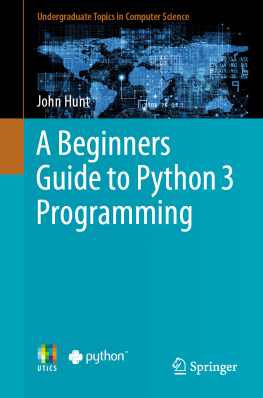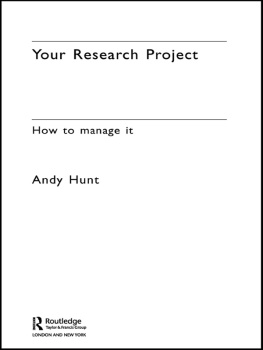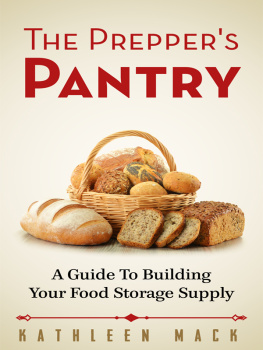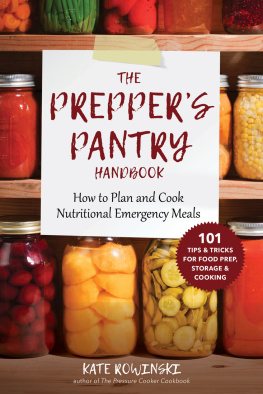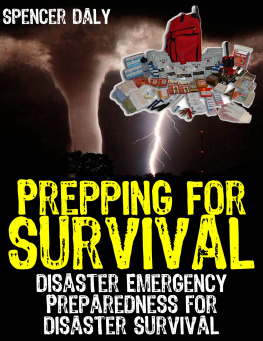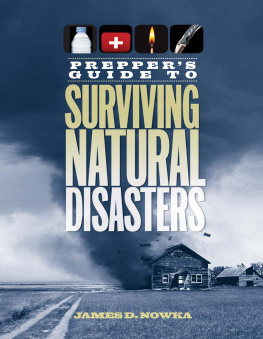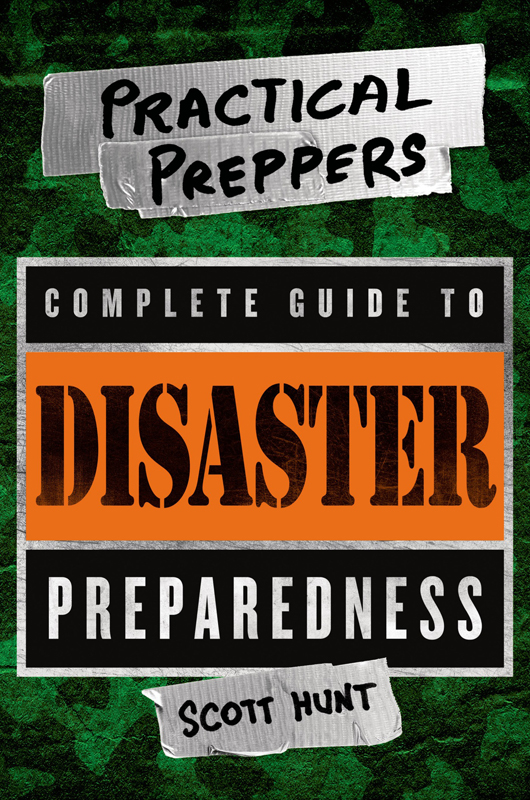
The author and publisher have provided this e-book to you for your personal use only. You may not make this e-book publicly available in any way. Copyright infringement is against the law. If you believe the copy of this e-book you are reading infringes on the authors copyright, please notify the publisher at: us.macmillanusa.com/piracy.
CONTENTS
To all those who look ahead, see whats coming, and prepare the best they can to help others. And, to those who when disaster strikes, head to the crisis to ease pain and suffering.
ACKNOWLEDGMENTS
I would like to acknowledge Jesus, my Lord and Savior, who has gone to prepare a place for me.
This book would not have been possible without the support and encouragement of my lovely wife, Lori. Her desire to be prepared and her medical expertise were invaluable to the writing of the book.
A special thanks to my sweet children, Reba, Ellie, Sara, and Elijah, who helped out so much around the house and farm so I could have more time to devote to the book.
Josh Hudson for sweating the details of finding and photographing the images for the book.
Anne Brewer of St. Martins Press for her foresight and assistance throughout the project.
INTRODUCTION
What are you preparing for? The basic necessities to survive any disaster scenario are usually all the same. This is one of the reasons I chose to write this book. Focusing too narrowly on just one doomsday concern can lead to the neglect of general life-saving solutions that will be useful no matter the situation. Three of the primary lessons you will discover as you read through the following chapters revolve around the importance of assessing your current situation, building upon or refining existing preps, and the difference between sustainable and grid-dependent systems integral to your survival.
As I was writing chapter 1 of this book, the most powerful storm on record was occurring. Super Typhoon Haiyan was the most powerful recorded typhoon to ever hit land and likely the deadliest natural disaster to hit the Philippines. During the storm I was contacted by a prepper and YouTube subscriber from the Philippines who, because of his preparations, had food and water. The world we live in is very unstable. We are seeing natural disasters of biblical proportions. In Sumatra in 2004 at least 280,000 people were killed by a tsunami. The Fukushima disaster in 2011 is a prime example of the deadly nature of man-made accidents. Who would have ever thought a tsunami, earthquake, and nuclear disaster could happen all at once? In the United States, Katrina in 2005 was the perfect storm. New Orleans is a city built eight feet below sea level, with aging infrastructure and poor municipal planning. NOLA residents were lured into a false sense of security; after all, the Crescent City had weathered a multitude of hurricanes before. Hurricane Sandy in 2012 was a new hybrid storma blizzard/hurricane never before recordeda Superstorm. In 2013, Colorado suffered massive wildfires and flooding while South Dakota experienced an early season blizzard that killed seventy-five thousand cows. The hits just keep on coming.
The federal governments continued lack of action in regard to the nations most often ignored piece of infrastructure, the power grid, could pose a disastrous future for America. The power grid is incredibly fragile, and most people who are preparing for TEOTWAWKI (The End Of The World As We Know It) expect that a disaster will bring it down. Preparing for disruption of services is a noble venture that gives peace of mind. Whether it is an economic downturn or a disruption from a solar flare that destroys life as we know it, the preparedness techniques are all the same. Our long-distance systems, like widely distributed power, medicine, and food, make us extremely susceptible to enemies or weather events. Living sustainably offers an independent existence.
Planning is the key to Preparedness. This book details straightforward solutions that must be implemented before the disaster occurs. Each chapter is structured in a way that begins with simple methods and then progresses to more complex strategies. Each chapter starts out with concepts and ideas that apply to the urban as well as the rural prepper. We believe you should be prepared no matter where you live. In order to alleviate suffering, help your unprepared neighbors, and curtail civil unrest, you must at least consider implementing what you will learn in this book. Everything Practical Preppers will share with you will be ideas that can be used in everyday life and not just for rainy day events.
WATER
Keep Your Head Above Water!
We never know the worth of water till the well is dry.
Thomas Fuller
Will you have enough water when a crisis occurs? The average American consumes approximately 1,600 gallons each day. Stop doing the math in your head. Yes, a human being would likely drown if they actually drank that much water in a single twenty-four-hour period. By consume, I mean usethe truest form of the definition of consumption.
Ponder for just a moment how often you turn on the faucet, relax in a hot shower, or push down a toilet handle each day. These few simple examples are obviously among the most important mundane water uses we must consider when attempting to grasp how much a single person depletes local water resources each day.
But if you start thinking larger, youll see that a drop of water that fell on a wheat field this afternoon is going to be part of my sandwich bread five months from now. If its a ham sandwich, a lot more water was used. It takes roughly 52 gallons of water to make one glass of milk. It takes more than 600 gallons to make a quarter-pound hamburger. A total of 2,800 gallons of water is used to make one pair of jeans.
Our daily lives carry a giant water footprint. Water is necessary for life. The sophistication of the society that an individual dwells in is determined by the amount of water consumed. While living in a first world country may be luxurious at the moment, such a scenario is not sustainable for long periods of time during either a man-made or natural disaster. The ability to support large groups of people living in high-population-density areas is greatly diminished during disasters.
Think about your water supply being cut off or contaminated. Who will survive? Those with clean, potable water will still be among the living after the dust clears. The human body can last for three to five days, at the most, without water. Securing a clean water source must be your primary preparedness objective, regardless what type of doomsday disaster you feel is looming on the horizon. When a catastrophe becomes reality, potable water will be in both high demand and short supply.
Once the reality of exactly how much water is typically consumed by your family each day sinks in, it is time to begin figuring out how to source clean water. In a first world country, municipal systems deliver clean water to residences by a vast array of pumps, pipes, filters, and chemicals that render open-water sources drinkable. These expensive systems serve the masses and usually provide seamless delivery of life-sustaining water. Individuals dwelling in population-dense areas can certainly store this water in appropriately sized containers.
Municipal water is typically treated with chemicals such as chlorine, fluoride, aluminum, and ammonia. Ammonia has had to be added in recent years. It combines with chlorine to form chloramines, which are now found in 20 percent of American water supplies. Water quality continues to deteriorate to the point where waste water treatment plants produce water that is more pure than the water produced by municipal water plants. The greatest challenge to the waste-water industry is the psychological barrier to the end product of waste-water treatment plants. The removal of unwanted contents will be dealt with in the purification section of this chapter. If you only have municipal water as your source, your only solution is to store enough for you to weather the storm. I am not belittling this solutionit is a great solution.



